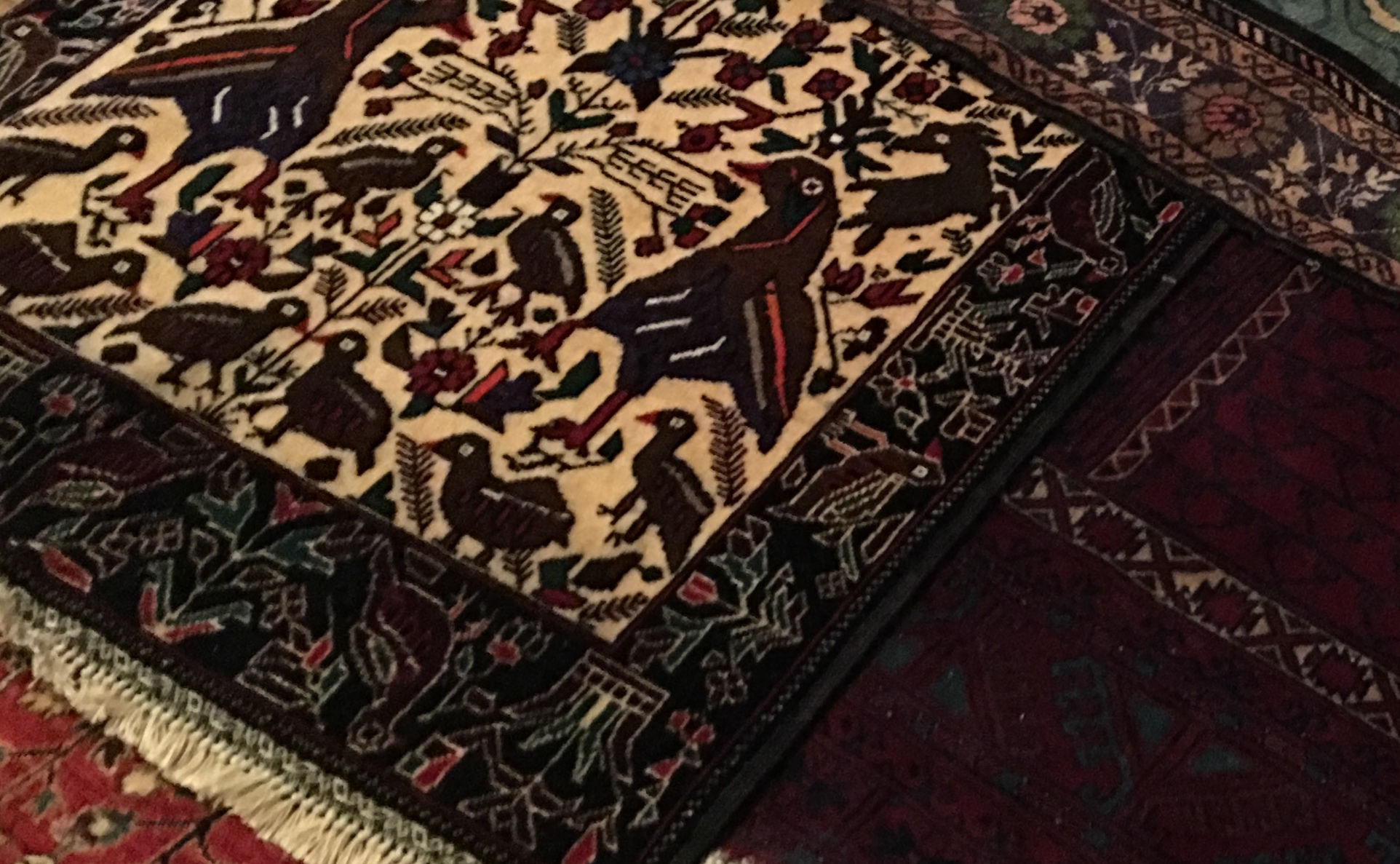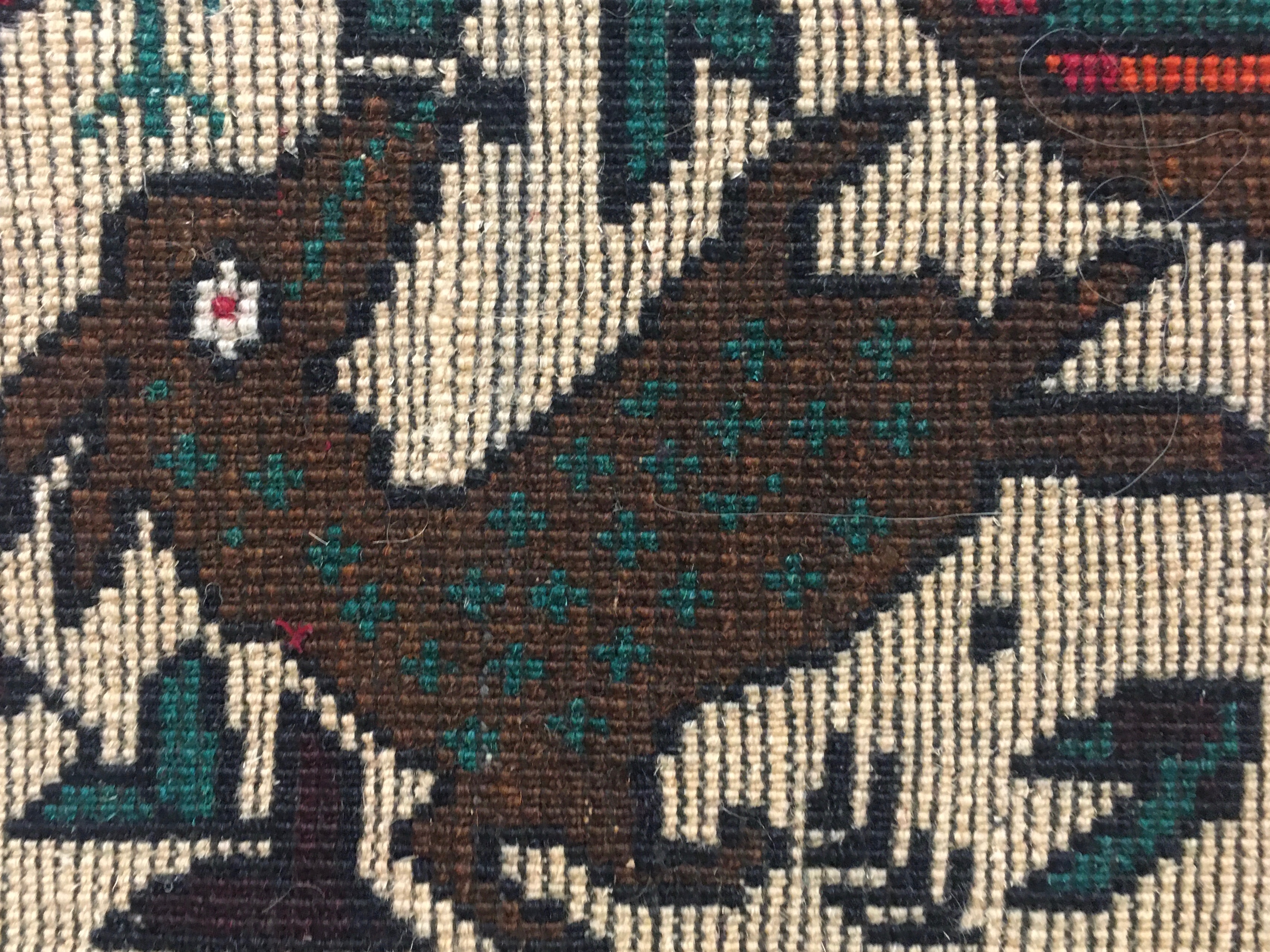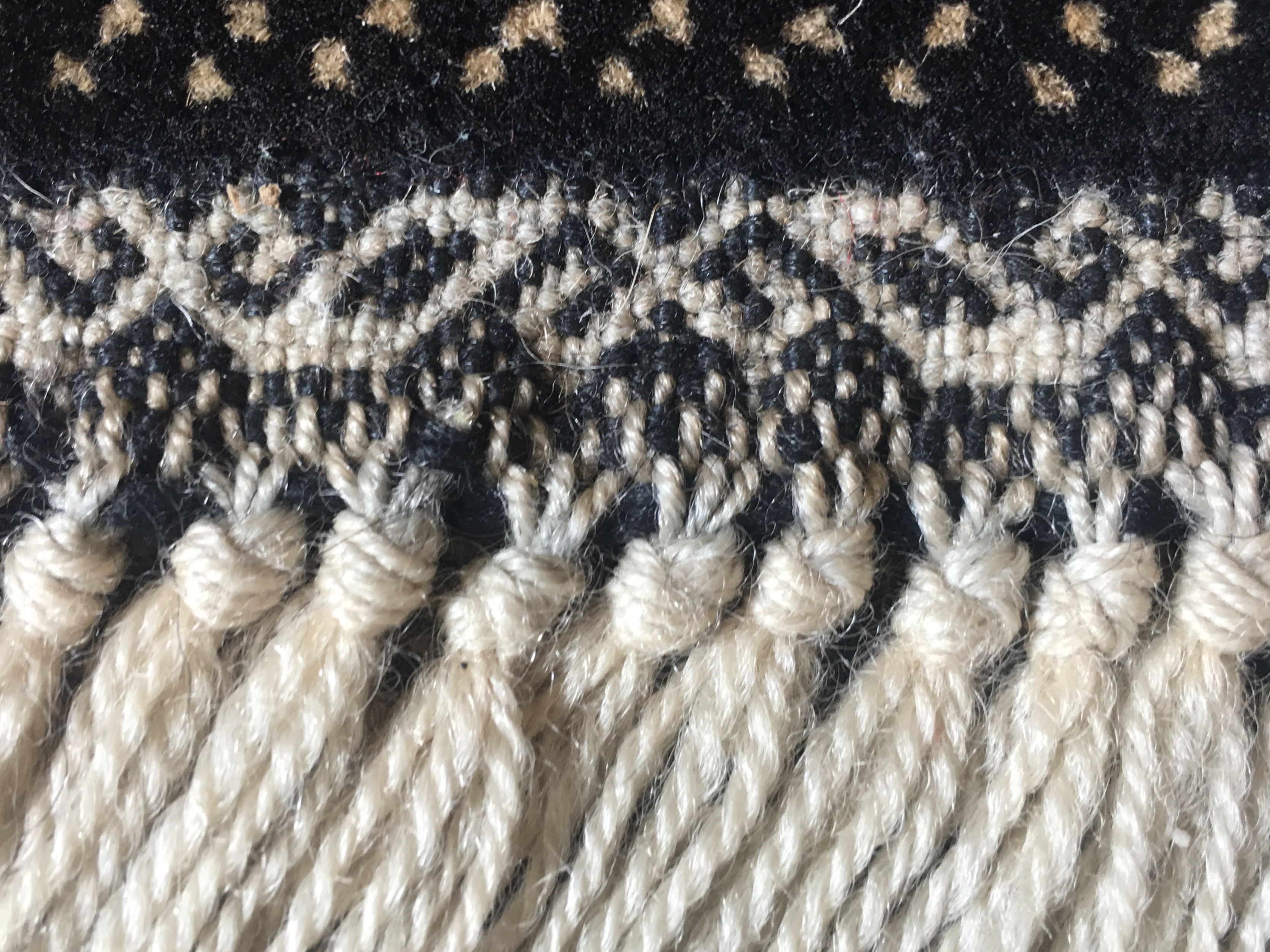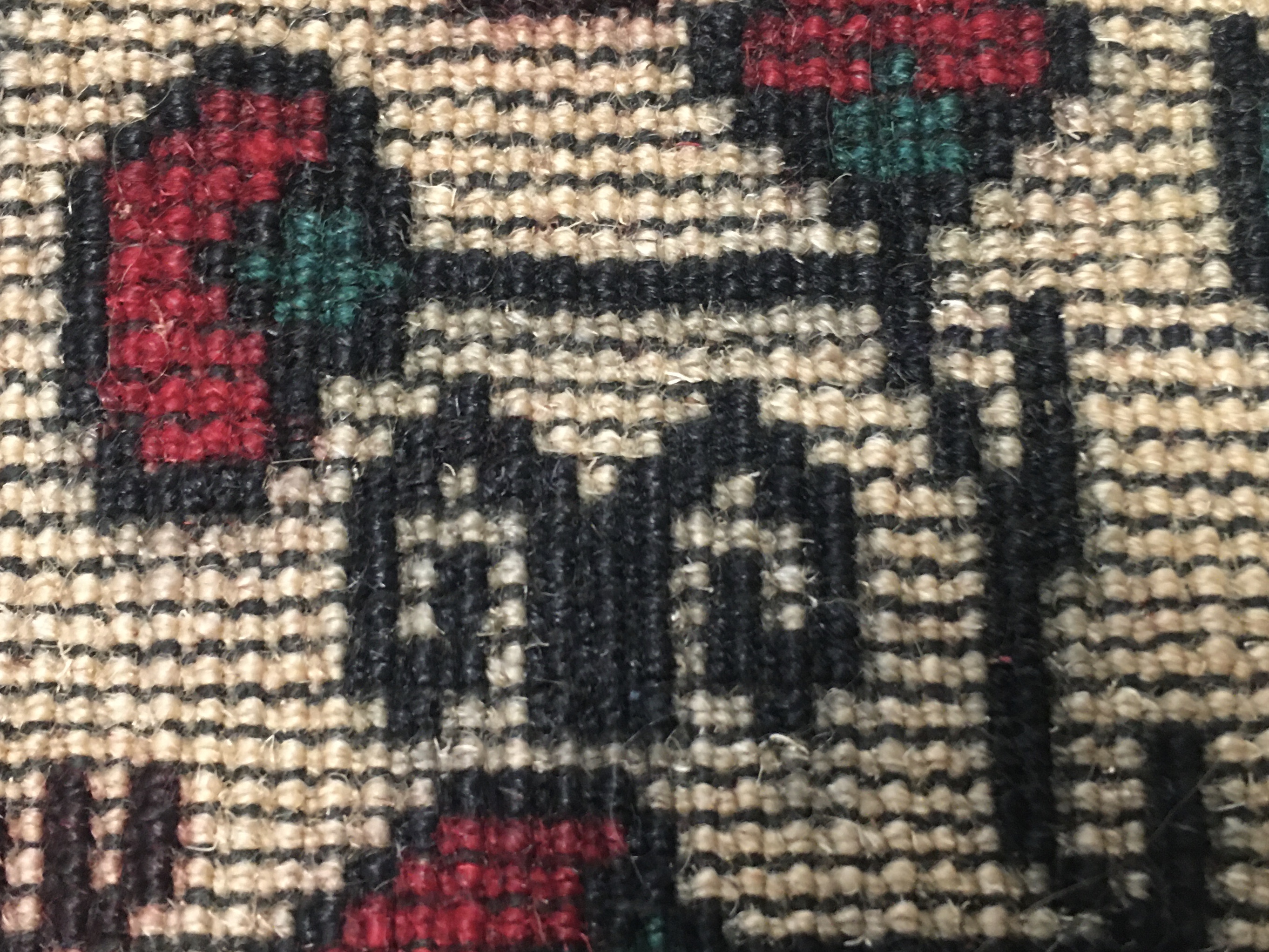
Check here for more information on the homepage rugs.
Nancy Small with Riyaz Bhat

Our material surroundings slip into the everyday semiconsciousness of our lives. We don't think about them until we need them or stub our toes on them. However, stories live in things. Some stories are of machinery and mass production. They might invite us to reflect over the ethics of labor practices. Other things have been made by hand, with careful technique, an artistic eye, or a sentimental inspiration. Attending to the stories that our things tell requires first, stopping to acknowledge their narrative power; second, a curiosity about how those stories work and what they say; and third, a means of inspecting or observing the thing to foreground the stories it may tell.
Before continuing: what do I mean by the terms story and narrative? The two are often used interchangeably. But by story, I mean shorter tellings of specific situations. A story includes an actor/character, an event, and a point for its telling; however, all of these may not be explicitly expressed. Similar to an incomplete or enthymematic argument in which one or more pieces of the puzzle are left out and filled in by the reader/listener, stories can be enthymematic, too (see Small, 2017a, p. 245). A narrative develops over time as multiple stories converge. Narratives are typically shared by groups and serve as the glue in social construction of group identity. Narratives, which are built of stories, tell us how things came to be, how things are, and how we function within the world. New stories are always being offered to the narrative and sometimes result in slow narrative evolutions and/or sudden disruptions (Martinez, 2020).
While the importance of storytelling and narrative are universal, specific story-related terms themselves may be grounded in difference. For example, notions of time, place, and actors/agency may vary. Therefore, interpretations of a story's structure and how those interpretations relate to encultured expectations, norms, and values are always situated. Modes, purposes, and styles of storytelling, including representations, pacing, emplotment (linearity, circularity, spiraling, episodic, etc.), also vary (for example, see Choi, 2015; McCabe, 1997). In this project, the framework is grounded in my white Eurowestern upbringing and education.
Here, I propose a method for reading handmade textiles as stories—memoirs or rhetorical assertions—of their makers and their making. Such stories differ from Cooper's (1843/2012) handkerchief. It tells its own story rather than that of its creator. Instead, this method might allow us, as readers, to tack in and carefully observe a textile, as well as tack out to contextualizing resources for clues as to the item's maker as a fuller human subject. Such a re-cognition is a feminist rhetorical practice. In Feminist Rhetorical Practices: New Horizons for Rhetoric, Composition, and Literacy Studies, Jacqueline Jones Royster and Gesa Kirsch (2012) "articulate a new analytical model, using feminist practices, for rendering women's rhetorical performances" based in "a set of values and perspectives, first of all, that honors the particular traditions of the subjects of study, respects their communities, amplifies their voices, and clarifies their visions" (p. 14). As discussed in Warp & Weft, handcrafts are relegated to the domain of the feminine, marginalizing them in relation to more important artistic endeavors. Rethinking the rhetorical value of such items honors them as well as the agents who made them.
Within Royster and Kirsh's model, "critical imagination" creates space for a strategic accounting "for what we 'know' by gathering whatever evidence can be gathered and ordering it in a configuration that is reasonable and justifiable in accord with basic scholarly methodologies" and then invites us "to think between, above, around, and beyond this evidence to speculate methodically about probabilities, that is what might likely be true based on what we have at hand" (p. 71). While their examples seek out "tensions, conflicts, balances, and counterbalances as critical opportunities for inquiry" (p. 72), they are working with archival information regarding their women rhetors that other situations may not offer. We might know a maker's name (or not), age or temporal location (or not), physical location (or not), and so forth. Therefore, the following framework extends critical imagination to the gathering of additional kinds of evidence, although still with scholarly rigor. Using contextualizing research in support of a material reading might then yield possibilities for methodical speculation.
Reading a textile as material memoir purposefully centers questions of lived experience, of the embodied process of composing as well as being composed. Such a reading seeks to learn more about the artistic agent in her creative contexts. Although all aspects of a systematic method are not required for reading a textile as a memoir, a framework can remind us of the multiple ways the textile might speak. The following set of narrative–rhetorical terms purposefully hearken back to the contexts and agency of the person who made it.
Genre is the textile's general type of design, its form as an indicator of its presumed use alluding to a particular need or desire in the life of the maker and/or recipient.
Content refers to the communicative messages composing the text. For a textile, this will include a more holistic consideration of what the piece communicates through its design, including as consistencies, inconsistencies, adaptations, and improvisations.
Plot is constituted by a timeline of events, and clues to the construction process hint at the action unfolding around the material object's creation. For example, a quilt that has been made, used, worn, and repaired tells a palimpsestic story through its patches and reinforced bindings. Quilts and other items may also be made through established sequences of activity, and those sequences may indicate something about the maker’s situation.
Setting is where a story unfolds. For a handcrafted item, setting is the location of creation, which translates to access to the material supplies and technologies required for production.
Symbols, such as motifs and other insignia, on a material object communicate cultural meanings and affiliations. Motifs may date back millennia, evoking complex composites of history, values, and beliefs. Conversely, they may be highly personal and esoteric to the individual maker and/or her family.
Stylistics liven up symbolic activities and personalize them to the communicator, both as an individual and as a representative of their communities of belonging. In the creation of artisanal textiles, stylistics appear in a variety of ways, including but not limited to the selection, production, and/or combination of the materials used, selection and adaptation of motifs or genre, or combinations of choices leading to overall content and presentation with a unique holistic style.
Context, Kairos, Exigence, Purpose, and Audience go beyond features of the material artifact's composition, as broader situational factors shape how an item is read and how a maker is critically imagined.
The (Contextualized) Reader of the material item plays an undeniable role in any interpretive activity. Listening, observing, and thinking across time, spaces, groups, and cultures, readers must readily account for their own relationalities to the text, its author(s), the settings, stylistic patterns, and more. Readers must critically reflect over their own backgrounds and belongings, their own roles, motivations, purposes, their own support resources, and their own limitations as well as the implications of how their reading might unfold, what might be misread or appropriated, and how such a reading might introduce colonizing effects.
Although these elements of examination are presented as discrete items in a list, they overlap. For example, setting alludes to material and technological affordances, but might also be indicated through how a textile has worn or degraded over time. Style and content can be considered by tacking into details but also by holistic considerations of an artifact in relation to the time, location, and/or agent of its creation. In that holistic consideration, setting, symbols, and other features are subsumed under style and/or content. The reader's access to support sources affects the process of reading through the rest of the framework. For example, without the generous expertise Riyaz Bhat brought to this project, information about Baloch tribal life would have been much sparser and the reading of the Shirin rug more difficult, if not impossible. Perhaps even more interesting in the examination of handmade artifacts are variations and/or improvisations, as these can be points at which the maker might be peeking through the fabric of tradition to assert her own presence.
Such a method of reading can begin with the textile itself but benefits from additional research using sources to illuminate historical, cultural, environmental, and other contexts. The next sections, Warp & Weft and Selvages, turn specifically to Central Asian makers to address two crucial forces at play: diminishment of women's contributions and commodification of tribal textiles. Together, these forces sharply erase the agency and presence of the artisan weaver and motivate the re-reading to come.


